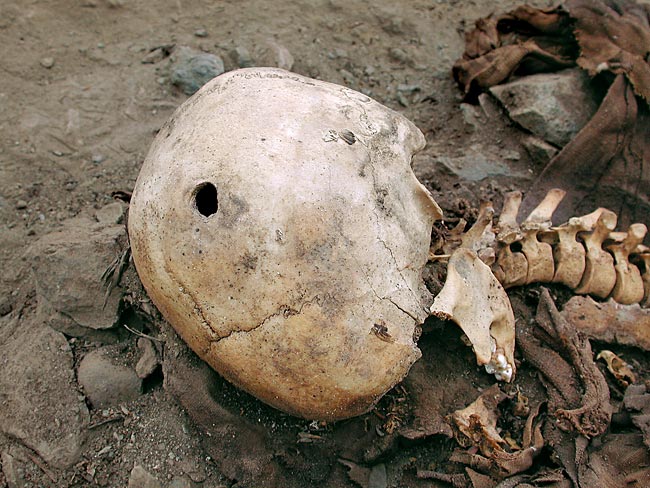'First Gun Victims' Discovered

WASHINGTON (AP) — The musket blast was sudden and deadly, the killing nearly 500 years ago of what may have been the first gunshot victim in the Western Hemisphere.
“We didn't expect it. We saw this skull and saw the almost round hole and thought people must have been shooting around here recently,” said Guillermo Cock, an archaeologist who found the remains near Lima, Peru.
But he realized that the skull was ancient, and a recent bullet strike would simply have shattered it, Cock said in a telephone interview.
The skull was found among a large group of bones of ancient Incas, who had died violently in the early 1500s as the Spanish Conquistadors battled the native empire.
The bones were in shallow graves, leading the archaeologist to speculate the burials were done hurriedly during conflict, perhaps an uprising against the Spanish in 1536.
To be sure this was a gunshot wound — making it the earliest one documented in the Americas — the skull was studied by forensics expert Tim Palmbach at the University of New Haven, who brought in other experts.
Al Harper, director of the Henry C. Lee Institute of Forensic Science in New Haven, Conn., said the team “tried to rule out all kinds of causes of the hole — a rock from a slingshot, spear, sledgehammer.” Harper and Palmbach studied the skull with a powerful scanning electronic microscope.
Sign up for the Live Science daily newsletter now
Get the world’s most fascinating discoveries delivered straight to your inbox.
“We all thought it was a million-to-one chance that we would find any traces of metal on a skull that old, but it was worth a try,” Harper said in a statement.
But there they were, fragments of metal from a musket ball impregnated the area surrounding the hole.
Cock and archaeologist Elena Goycochea discovered the burials in a Lima suburb in 2004 and have since recovered 72 apparent victims of violence from the site.
“These bodies were strangely buried,” Cock said. “They were not facing the right direction, they were tied up or hastily wrapped in a simple cloth, they had no offerings and they were buried at a shallow depth.
“Some of the bodies also showed signs of terrible violence. They had been hacked, torn, impaled — injuries that looked as if they had been caused by iron weapons — and several had injuries on their heads and faces that looked as if they were caused by gunshots.”
One skull in particular had both an entrance and exit wound, suggestive of a musket ball and prompting him to seek experts to study it. A plug of bone from one of the holes was recovered nearby, he added.
The conclusion: A musket ball less than an inch in diameter struck the back of the skull and passed through the head.
“This conclusively proves that the person was killed by a gunshot, and he is the first identified shooting victim in the Americas,” Cock said.
Since the initial find, at least two other apparent gunshot victims have been identified and the research is continuing.
Cock discussed his find during a visit to the National Geographic Society, which supported the work. His findings will be detailed June 26 on a NOVA/National Geographic television special, “The Great Inca Rebellion.”
In 2002, Cock reported finding more than 2,000 Inca mummies buried beneath a shantytown near Lima, a find he said helped shed light on the life, health and culture of this civilization.









